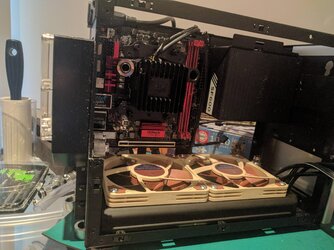Hi all
I'm building an NCase M1 with 2 x 240mm radiators and will be (by necessity, I think) using the Apogee Drive II (AD2).
I've pretty much got my loop planned out and I'm now thinking about how to bleed the system. This is especially tricky given that the AD2 will be fixed to the board but must (when performing the bleed) be below the res. You can see a picture here: (the res is on the back of the case, a FrozenQ NCase M1 res).
The relevant bits of the instruction manual for AD2 say:
the lines leading to, and exiting from the pump must be full of coolant*
*I'm aware that watercooling pumps must have fluid coming in but wasn't aware that they had to have fluid coming out? How is this achieved?
and therefore recommends not to fix the AD2 to the motherboard (so you can move it to the lowest point).
I've been considering my options for bleeding the system and think there are four:
1. Leave the AD2 loose and move it to the lowest point
This might work in theory but the problem, as I see it, is that in order to move it you would need to put in quite a bit of extra tubing which might be problematic (for example, once fixed after the bleed it may need to kink to fit).
2. Rotate the case so that the res is at the top
Having rotated the case, it is possible to get the res to the top but it isn't be a huge amount and I'm not entirely sure that it would work given the location of the ports on the res.
3. Directly filling the AD2 input port
You could disconnect the res fitting and put a funnel in the tube which leads to the AD2 input port and bleed the system this way. I think this would work but there is a real danger that the res would overflow into the unconnected drain port.
4. Put a drain valve in between the res and the AD2
You could use something like this - https://koolance.com/drain-valve-for-id-10mm-3-8in and place it between the res and the AD2, put a fitting + some tubing on the g1/4 end and use a funnel to feed the coolant in. Again you may need to be careful to check when the system is full or it may come back out of the drain valve (unless closed in time)? Also, it may be a tight fit getting this drain valve in between the res and the AD2.
I'm sorry that this is so long but I'd be really grateful for any thoughts on the above options (or any options which I may have missed).
Many thanks
Tom
I'm building an NCase M1 with 2 x 240mm radiators and will be (by necessity, I think) using the Apogee Drive II (AD2).
I've pretty much got my loop planned out and I'm now thinking about how to bleed the system. This is especially tricky given that the AD2 will be fixed to the board but must (when performing the bleed) be below the res. You can see a picture here: (the res is on the back of the case, a FrozenQ NCase M1 res).
The relevant bits of the instruction manual for AD2 say:
the lines leading to, and exiting from the pump must be full of coolant*
*I'm aware that watercooling pumps must have fluid coming in but wasn't aware that they had to have fluid coming out? How is this achieved?
and therefore recommends not to fix the AD2 to the motherboard (so you can move it to the lowest point).
I've been considering my options for bleeding the system and think there are four:
1. Leave the AD2 loose and move it to the lowest point
This might work in theory but the problem, as I see it, is that in order to move it you would need to put in quite a bit of extra tubing which might be problematic (for example, once fixed after the bleed it may need to kink to fit).
2. Rotate the case so that the res is at the top
Having rotated the case, it is possible to get the res to the top but it isn't be a huge amount and I'm not entirely sure that it would work given the location of the ports on the res.
3. Directly filling the AD2 input port
You could disconnect the res fitting and put a funnel in the tube which leads to the AD2 input port and bleed the system this way. I think this would work but there is a real danger that the res would overflow into the unconnected drain port.
4. Put a drain valve in between the res and the AD2
You could use something like this - https://koolance.com/drain-valve-for-id-10mm-3-8in and place it between the res and the AD2, put a fitting + some tubing on the g1/4 end and use a funnel to feed the coolant in. Again you may need to be careful to check when the system is full or it may come back out of the drain valve (unless closed in time)? Also, it may be a tight fit getting this drain valve in between the res and the AD2.
I'm sorry that this is so long but I'd be really grateful for any thoughts on the above options (or any options which I may have missed).
Many thanks
Tom
